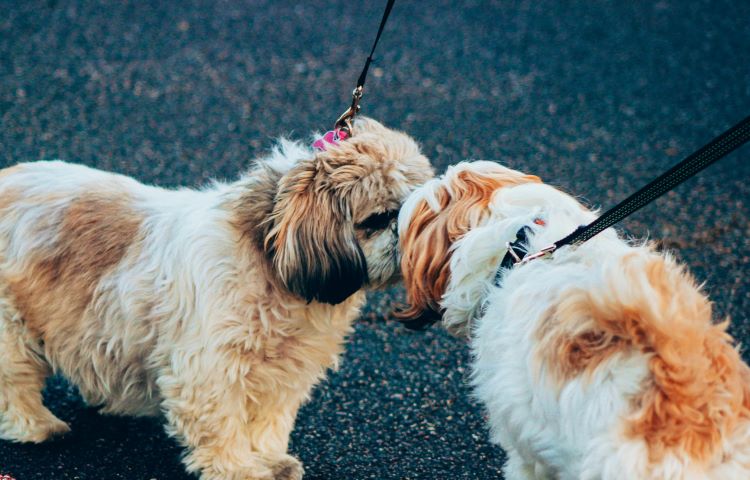Ready to help treat your pet to a healthy life?
What is Small Dog Syndrome? When Canine Behavior Needs Correction
By : Brianna Gunter | Published Oct 1, 2024

Is your small dog a bit… bossy? Or perhaps they are extra vocal, with a personality that seems bigger than their tiny body. If so, they could be a prime example of what’s colloquially known as “small dog syndrome” or sometimes, SDS. While not an actual medical condition, this is a potentially serious behavioral pattern that can cause problems for humans and animals alike.
Small dogs often capture our hearts with their cute, tiny frames and lively personalities. But it’s when those personalities become aggressive, demanding, or overly territorial that small dog syndrome can be an issue. The good news is that understanding its root causes, recognizing the signs, and implementing proper training techniques can all help with ensuring this behavior doesn’t lead to disaster.
Why is small dog syndrome a big deal?
Although the behavior may seem harmless at first due to a dog's small size, it can lead to several issues that affect your pet’s relationships with people (including yourself) and other pets, and their overall welfare. SDS can also negatively impact your dog’s mental health, as their constant state of alertness or need for control can put them in a perpetual state of stress. That’s no good for anyone!
Many dogs with small dog syndrome are also more likely to bite, growl, or otherwise act out against those who make them feel insecure. Aggression in a small dog may not seem as threatening as that in their larger counterparts, but it can still cause physical damage. It’s also important to keep in mind here that any dog bite can lead to legal difficulties in many areas, regardless of the dog’s breed. And speaking of breed, it’s not just larger canines who are known for aggressive tendencies — Chihuahuas, for example, are among the top aggressive dog breeds.
This doesn’t mean that if you have a Chihuahua (or any dog breed known for aggression), that they'll automatically act out. But it is a risk worth being aware of. Your dog may not learn healthy boundaries as a result of their aggression and stress, putting their own safety and that of others at risk. This kind of behavior can also prevent proper socialization and training, both of which are also fundamental to every dog’s safety and wellbeing, no matter their size.

Signs of small dog syndrome to watch out for
Is your dog’s personality just a bit colorful, or are they actually exhibiting concerning behavior that needs to be addressed? While every pup is different, there are several common signs that may point to small dog syndrome:
1. Excessive barking
Dogs with SDS tend to bark at the slightest provocation, whether it’s a visitor at the door, a car passing by, or another animal in the vicinity. The barking often seems out of proportion to the situation.
2. Aggressive behavior
Despite their small size, affected dogs may act aggressively toward other pets or even humans. They may growl, snap, or bite — especially when they feel threatened or want to assert dominance.
3. Jumping up on people
While many dogs jump up when excited, small dogs with SDS may do so constantly and without control. In more extreme cases, they may ignore commands to stop.
4. Territorial behavior
They might guard their food, toys, or even their owner with more intensity than necessary, displaying possessive aggression. While dogs of all breeds have the instinct to protect what’s theirs, small dogs are often less likely to be trained appropriately in this area.
5. Fearful or anxious behavior
Small dogs may show signs of stress or anxiety when in unfamiliar environments or around larger animals, causing them to react defensively. Keep this in mind when responding to a pet behaving unfavorably — while their behavior may seem aggressive or mean, it could just be from fear or stress. While training dogs for more positive reactions, it’s important to find the source of this stress and address it.
6. Demanding attention
Some small dogs become overly demanding of their owner’s attention, pushing boundaries in ways that can become frustrating. They might bark, whine, or misbehave to get what they want.
Common causes of SDS
The root causes of small dog syndrome show why addressing the behavior is so important. One of the primary causes of Small Dog Syndrome is how small dogs are treated differently than larger dogs by their human companions. Due to their diminutive size, small pups often aren’t seen as threatening when acting aggressive. This makes it more likely for behaviors like jumping up or nipping to be dismissed as harmless.
At the same time, small dogs may feel more threatened by the large, scary world around them. Being small means they are physically more vulnerable than larger dogs, and they may overcompensate by trying to appear more dominant or aggressive to ward off potential threats. It’s a form of self-protection that can backfire and trigger responsive aggression from other pets (and negative opinions from humans).
Another contributing factor is limited socialization. Without adequate exposure to different environments, people, and other animals at an early age, small dogs may not know how to navigate them appropriately.

The importance of proper training in small dogs
It’s crucial to understand that small dog syndrome largely comes down to a lack of training. It may not seem like it, especially if your dog can do tricks or respond to some basic commands, but not being able to control themselves results from unenforced boundaries. All dogs may get protective from time to time, for example, but with proper training this behavior becomes more cautious and reserved than aggressive.
Fortunately, Small Dog Syndrome is not irreversible. With proper training, patience, and consistency, the behaviors associated with it can be modified or even eliminated entirely! Depending on the age of your dog, you may benefit from working with a trainer who specializes in smaller canines. Nevertheless, here are some strategies for addressing Small Dog Syndrome:
- Set boundaries — Just like their larger counterparts, small dogs need clear rules and boundaries. This means not allowing them to jump on people, bark incessantly, or display aggressive behaviors without correction. Teach them basic commands like “sit,” “stay,” and “quiet,” and consistently enforce these rules.
- Don’t overindulge —It’s easy to “baby” a small dog, carrying them everywhere and giving in to their demands, but this only reinforces that they are in charge. Instead, encourage independence by letting them walk on their own (and encouraging exercise in general!) and engage in normal dog behaviors like exploring their surroundings.
- Socialization — Expose your small dog to a variety of experiences, environments, people, and other animals from a young age. This helps them learn that not every situation is a threat, reducing their tendency to overreact or become defensive.
- Reward calm behavior — Positive reinforcement is crucial for training any dog. Reward your dog when they display calm, appropriate behaviors, and avoid reinforcing bad habits. Treats, praise, and affection can all be used to encourage good behavior.
Ultimately, the key lies in understanding that small dogs require the same level of training, socialization, and discipline as larger dogs.
Avoiding future problems
Prevention is always better than cure when it comes to Small Dog Syndrome. By starting training early and treating your small dog with the same respect and boundaries you would a larger dog, you can avoid many behavioral issues. Remember, a well-trained dog, regardless of size, is a happier and more confident pet.
Small dogs may be tiny, but their behavior can be as impactful as that of any larger breed. It’s important to recognize that they are still dogs with the same needs for structure, leadership, and socialization. With the right approach, small dogs can be just as well-behaved and enjoyable as their larger counterparts.
